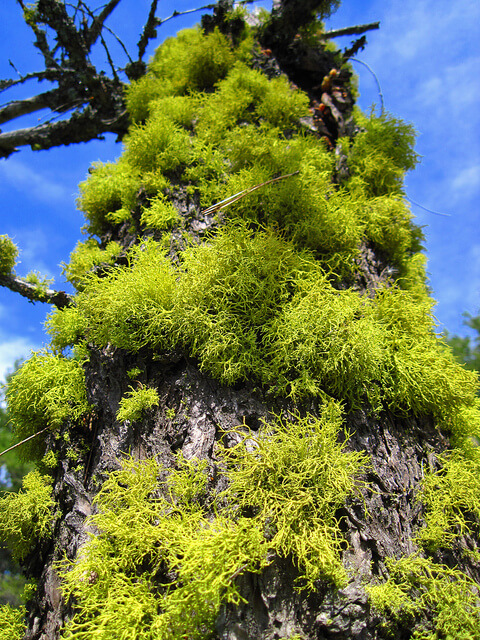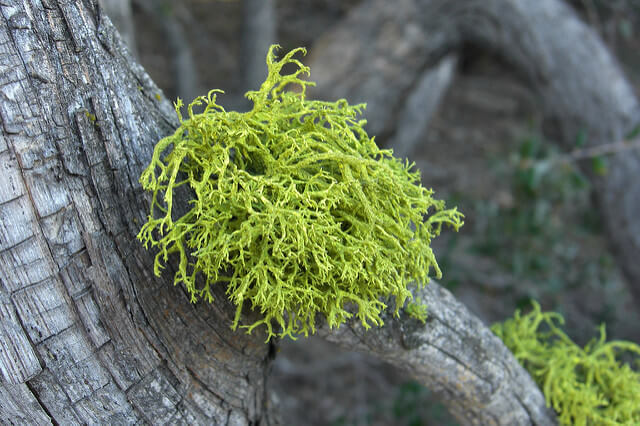Wolf Lichen
by Danielle Gardner
Broadcast 1.24.2016

Photo by Forest Service Northern Region, CC 2.0.
Listen:
Although small and unobtrusive, an estimated 13,000 to 17,000 species of lichen spread across the Earth, from the Arctic to the equatorial tropics. One of those species, more noticeable than most, is Letharia vulpina, a brilliant fluorescent yellow-green, moss-like lichen that clings to the bark and wood of living and dead trees throughout the world, from sea level to timberline.
Recently, while sitting under a large ponderosa pine in a northwestern Montana forest, I observed an abundent cluster of Letharia vulpina on a nearby dead branch. Looking up, I found that the pine itself was a quiet host to many more clusters of Letharia. Looking further I found that found that the lichen was well established throughout the forest. I knew that this particular forest is home to a herd of mule deer and bighorn sheep, as well as the occasional black bear, imported wild horse and a slew of plant-eating insects. So I wondered how such a succulent-looking plant could flourish seemingly unharmed by browsers. The answer lies in the brilliant yellow substance that gives it its appealing appearance: vulpinic acid.
Historically, Letharia vulpina was known as wolf moss. Dried and ground into powder, it was sprinkled on meat to poison wolves and foxes. Today, lab studies show that a light dusting of it on garden plants, in quantities much less than those existing in the lichen itself, will reduce predation from slugs and snails by 85 percent. Letharia vulpina’s color is not the bright chlorophyll, but rather a bitter, poisonous acid.
Not all lichen species are as inedible as wolf moss. Many serve as a prime nutrient source for species from reindeer to humans. In Switzerland, for example, Cetraria islandica is harvested for the production of throat lozenges, herbal sweets, and herbal teas. In Japan, the lichen Umbilicaria esculenta is boiled and seasoned with vinegar or sesame paste and served as a delicacy with salad. Historically, several cultures have depended upon on lichen as a food source in times of famine, and some believe it was actually lichen that served as the “manna [bread from God] of the Israelites in their exodus from Egypt.” More recently, it is reported from some cultures in the northern hemisphere that equal parts lichen and wheat flour “can be made into tasty biscuits.”
Although Letharia vulpina will never be enjoyed toasted with butter, humans can have an impact on it. Lichens grow extremely slowly, increasing imperceptible amounts in a year—only about four millimeters. They also have great longevity, possibly surviving for thousands of years. This makes them vulnerable in two ways: because they live so long, lichens are more sensitive to air pollution and are often obliterated from the hillsides of smog-producing areas. Secondly, because lichens are so slow to grow, they are unable to recuperate quickly when harvested. Some regions have completely lost local populations of Letharia vulpina because of their use in floral arrangements. In the Pacific Northwest Letharia vulpina thrives, as air pollution hasn’t been severe and the flower arrangers are safely at bay.
As we study the further potential that vulpinic acid has to protect crops from hungry herbivores, however, the very substance that protects Letharia vulpina may ultimately be its demise. Too harsh for human consumption, the brilliant yellow lichen is just harsh enough that it may become a tool in the ever more urgent development of global agriculture.

Photo by Jason Hollinger, CC 2.0.
Every week since 1991, Field Notes has inquired about Montana’s natural history. Field Notes are written by naturalists, students, and listeners about the puzzle-tree bark, eagle talons, woolly aphids, and giant puffballs of Western, Central and Southwestern Montana and aired weekly on Montana Public Radio.
Click here to read and listen to more Field Notes. Field Notes is available as a podcast! Subscribe on iTunes, Google Play, or wherever you listen to podcasts.
Interested in writing a Field Note? Contact Allison De Jong, Field Notes editor, at adejong [at] montananaturalist [dot] org or 406.327.0405.
Want to learn more about our programs as well as fun natural history facts and seasonal phenology? Sign up for our e-newsletter! You can also become a member and get discounts on our programs as well as free reciprocal admission to 300+ science centers in North America!












